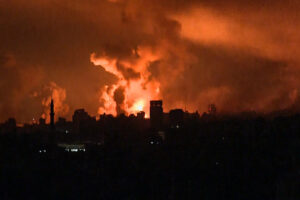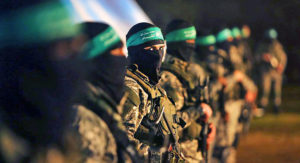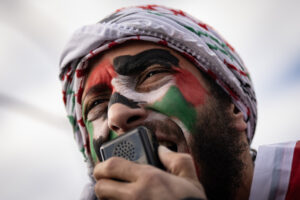Beirut, in the mid-20th century, was a synonym for Middle Eastern glamour, its Rue de la Phénicie a nocturnal haunt for Hollywood movie stars and Arab oil barons. In the early Fifties, when the city was in the Western press, it was mostly because Brigitte Bardot or Elizabeth Taylor were staying at the Hotel St Georges, where Kim Philby propped up the bar.
The cultural capital of the Levant, this Beirut styled itself as a home to great merchant families of the Middle East. In the Twenties, it had welcomed the Armenians, the refugees from Enver Pasha’s First World War genocide. In the Forties, it had accepted the Palestinians — not only penniless Galilee peasants but Jaffa intellectuals and Jerusalem landowners — who had either fled or were expelled by David Ben-Gurion’s armies in 1948.
But not only them. Cosmopolitan Beirut was the only Arab city that saw its Jewish population grow after the establishment of the state of Israel, as pogroms, persecutions and expulsion drove the ancient Jewish communities of Cairo, Alexandria, Aleppo, Damascus and Baghdad into exile. Freewheeling Beirut, with its champagne bars and singers, was for thousands of Middle Eastern Jews preferable to rationed, socialist and besieged Israel. It was more familiar.
This city snags on my family tree. It was this Beirut, at its very start in the late 19th century, which drew my great-great-great grandfather, Avraham Sassoon, from Aleppo. And it was here, in the 1910s, where his son, Moise Abraham Sassoon, chose to build a synagogue. He named it in honour of his father, Magen Avraham — or the Shield of Abraham.
That city was lost in the civil war that broke out in 1972. One of its most enduring images became the ruins of the Holiday Inn, as militias battled their way through the hotel district. The Jewish quarter of Wadi Abu Jamil emptied almost in its entirety. In my great-grandmother’s files are clippings, notes and desperate appeals for money sent to London from those that remained. But these also abruptly stopped around the time the synagogue itself was destroyed in the Israeli invasion in 1982, having been used as a Palestinian position.
In 2007, I visited these ruins, just a year after Israel had struck Hezbollah, demolishing whole streets in their stronghold of Dahieh. Locked-up, its roof caved in, I didn’t climb in for fear of booby-traps, but through the window I could make out faded Palestinian militia posters and what looked like ancient iodine capsules from their wounded.
This is the Lebanon we know today: a country synonymous with civil war, corruption and terrorism, its former glamour buried beneath the rise of Hezbollah, state failure and financial crisis. Breakdowns, from sewage to electricity to the central bank, have left every family fending for themselves. In 2020, when an ammonium nitrate explosion ripped through the port of Beirut, killing over 200 people and making over 300,000 homeless, it reeked of corruption, negligence and official fecklessness.
This has left Hezbollah the only functioning institution in the country — one which happens to be totally committed to ensuring the state does not function in turn. More than a state-within-a-state, the Iran-sponsored actor runs its own army and conducts its own foreign policy. Millions of Lebanese hang on its leader Hassan Nasrallah’s every word: only he will tell them if there is to be war with Israel.
The idea that these lands are tied together is an old one. The Bible twice recounts the borders of the Promised Land as extending from the mountains of northern Lebanon to the edge of the Negev. Even though the Israelites never conquered or even settled these lands, these mountains of cedars and Phoenician cities were seen as part of Canaan. Centuries later, the Crusaders thought so too. Across their Kingdom of Jerusalem, mostly modern-day Israel, and their County of Tripoli, roughly modern-day Lebanon, the tombs of knights recounted their deaths: “en Terre Promise”.
The Ottomans likewise saw these lands as bound. In the late 19th century until the empire’s demise, the vilayet of Beirut stretched from coastal Syria to south of Nablus. Then their fates diverged. Palestine became a British Mandate, to be a “Jewish National Home”; north of this was assigned to be French mandate territory.
Everyone in Damascus with a sense of history tells a story about how, when the French High Commissioner for the Levant, General Henri Gouraud, entered Damascus, he kicked the tomb of Saladin, before saying: “We’re back.” In reality, it was probably a deputy, but it captures something of the French attitude to Lebanon: not as explicitly as what Earl Balfour had wanted to the south, General Gouraud saw this new mandate as a national home for Middle Eastern Christians, led by its Maronite Catholics
These Christians, however, wanted Greater Lebanon. In an uncanny parallel to how Israel would think after the Six Days War some 50 years later, the Maronite Patriarch at Versailles set out demands for mostly Shia territories to the south, north and east of the old Ottoman district of Mount Lebanon — despite the fact that this expanded state would not, unlike this smaller enclave, have a clear Christian majority. This fateful choice set the stage for Lebanon’s crisis and decline decades later, as this narrow order would be overturned first by the Sunni Lebanese, then the Shia Lebanese with Hezbollah.
The parallel to Israel has never been lost on the country’s intellectuals and generals. Pre-1967 Israel was a state with a clear Jewish majority and unarguably a democracy. Today’s greater Israel, thanks to the occupation, administers a territory where there is similarly no clear Jewish majority. Not only Israel’s troubles but its state dysfunction stem from this point. For decades, it has been repeated that Israel must choose between being a Jewish state or a democracy. But there is a third risk: that the mess could eventually prove inextricable, ungovernable and foment internal conflict. In other words, a fate rather like Greater Lebanon.
The legacies of both British and French mandates eventually set the stage for the Lebanese civil war: not only had a narrow, Christian, even Maronite-run Lebanon proved unsustainable, but the mass influx of Palestinians in 1948, whose leaders would turn the south of the country into a revenge base to attack Israel, had permanently destabilised it. As Christian militias fought Palestinian, Arabist and leftist ones, Syria intervened, then Israel, with Ariel Sharon besieging Beirut in alliance with Phalangist militias to rout out Yassar Arafat. Civil wars within civil wars erupted within sects and alliances. The bloodshed didn’t stop until 1990.
Without realising it, in those first years after the war, Israel was tying its future to Lebanon, when it deported the leadership of Hamas to the latter’s south, which it then controlled. The Lebanese authorities refused to let them travel further than the valley of Marj al-Zohour. This is where they got to know the Shia movement that had emerged alone from the civil war with the right to keep its militia — Hezbollah. The alliance we see today was born here, in this rocky valley of wildflowers.
***
In 2007, I found myself in Dahieh, looking at Hezbollah’s victory exhibition of fluttering flags and captured Israeli equipment. Inside their office hung portraits of the Iranian revolutionary Ayatollah Ruhollah Khomeini and maps of occupied Palestine. Now I realise this “victory” — which allowed Hezbollah to cement its grip on Lebanon — is exactly what Hamas was seeking to emulate on October 7: a victory that would allow it to claim complete ownership of the Palestinian cause.
Today, when Hassan Nasrallah is photographed meeting the Iranian foreign minister in Beirut, underneath portraits of the ruling Ayatollah Ali Khamenei and his predecessor Khomenei, there is no way to know this is in Lebanon, except for the cedar flag tucked behind him. That summer, when I peered into those ruins, there were still hopes that the second Lebanon that emerged out of the civil war could find its feet. But it was already too late.
Through Hezbollah’s 2006 war with Israel, which it launched at a moment when it was under pressure to join the reconciliation process, it had made clear its militias would control the questions of war and peace. And then through countless refusals and blocking measures, it steadily paralysed the nation’s power sharing institutions.
In this, it found a loyal ally — corruption. As the paralysed state withered away, politicians of all backgrounds feasted on its remains. By 2019, the country had been left with no genuinely functioning institution apart from Hezbollah. One after the other these failed until the Central Bank was exposed as having engaged in financial engineering, prompting a 90% devaluation.
The scenes that followed — mile-long queues for fuel, hospitals in crisis and power outages — were the backdrop to the 2020 explosion. For a few weeks, symbolised briefly in a dramatic visit by President Macron, it seemed that public anger might force a change. Then it was lost, and all that remained was a simple question: is the political system completely broken — or is it just the players?
Today, some insist that the confessional system — a Maronite President, a Sunni Prime Minister, a Shia Speaker of Parliament, with parliamentary seats split between religions — no longer functions and needs to be replaced with federalisation, with each sect running its own enclave. Others claim there is no alternative to the current system, meaning the problem is really with the politicians. Like those south of the border furiously debating abstract one- or two-state “solutions”, there is an odd symmetry here.
The entire Levant feels stuck. The Lebanese, the Israelis and the Palestinians have been cornered by the same actors. The first is Iran, building up Hezbollah, to the point it is essentially a state, and Hamas, until it could strike deep inside Israel. The second are a caste of tribal politicians who, when they are not fanatics, are fantastically short-sighted or corrupt.
As Israel spiralled into four elections in five years, culminating in an attempted judicial coup that split society along secular and religious lines, it became clear that these are two nations with conjoined fates. Israeli politics, despite its classic electoral system, has deep resemblances to Lebanon’s confessional politics, with secular, settler, ultra-Orthodox and Arab parties all competing for resources for their “sector”. Former President Reuven Rivlin is more explicit, once referring to them as Israeli “tribes” — with their own towns, parties and corners of the country.
The civil strife that so weakened Israel before October 7 came from Netanyahu pitting these “tribes” against each other. In other words, he did the most dangerous thing you can do in Levantine politics. In the months before the Hamas massacres, the Israeli press was full of warnings of “civil war”, as commentators feared just how “Lebanese” the clash over the judiciary could get. My fear was that Israeli politics would become a sequence of “rioting” tribes, with Haredim refusing to serve in the army and settlers refusing orders in the West Bank. Not the Lebanese frontlines of the Seventies, but its paralysed present beckoned.
Both Israel and Lebanon’s failed politics conspired to give Hamas and Hezbollah their chance on October 7, opening up the prospect of a much wider war. If this does happen, the fate of Gaza, Tel Aviv and Beirut will again be shared — this time in even greater destruction. Hezbollah, with 150,000 rockets, can overpower Israel’s Iron Dome, leading to the kind of destruction its cities have been spared. Meanwhile, Israel’s retaliation, which officials warn would “destroy Lebanon”, could turn parts of it into Gaza.
The last time I stood at the Lebanese border, from the south, I was struck by how the same trees and hills just continued, unperturbed. I have often fantasised about what it would be like to drive north from Israel, past the Roman temples, Crusader castles, and the sites of recent wars to visit Beirut — my own private fantasy of peace. I used to feel sure I would do it one day. Today, I am not so sure.
Disclaimer
Some of the posts we share are controversial and we do not necessarily agree with them in the whole extend. Sometimes we agree with the content or part of it but we do not agree with the narration or language. Nevertheless we find them somehow interesting, valuable and/or informative or we share them, because we strongly believe in freedom of speech, free press and journalism. We strongly encourage you to have a critical approach to all the content, do your own research and analysis to build your own opinion.
We would be glad to have your feedback.
Source: UnHerd Read the original article here: https://unherd.com/




